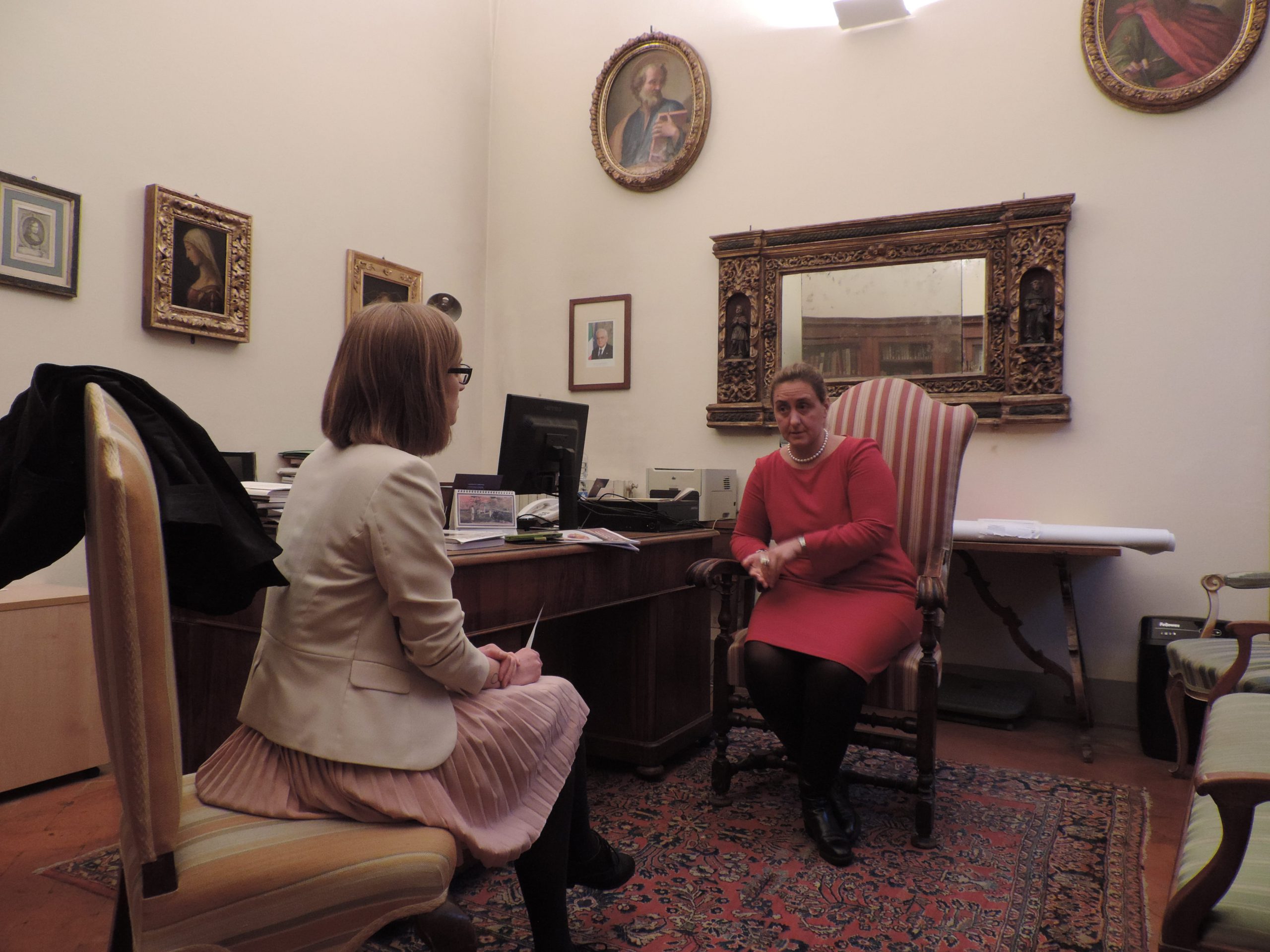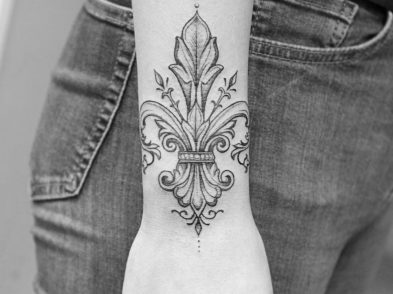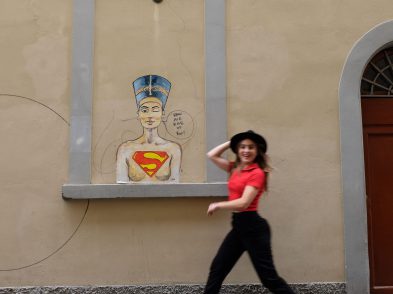The Bargello Museum, a treasure trove of Florence’s medieval and Renaissance sculptural masterpieces, is one of five museums comprising a network in the historic city center. Director of the Bargello Museums Paola D’Agostino spoke with The Florentine about the five institutions and her hopes for their future.

Ph. Giacomo Badiani
Samantha Vaughn: The Bargello extended its hours temporarily between April and November 2017. What plans are in order for the coming holiday season and next summer?
Paola D’Agostino: One of the biggest challenges for us is the dearth in human resources, and it’s not because of the reform that resources are lacking. On the contrary, what has happened is that creating independent institutions has made it even clearer that there’s a need to transform the whole organization of these places and make them more flexible and organized regarding staff and shifts. It’s an ongoing process in which we only partly have a say because our human resources are still managed by the ministry, meaning all employees have similar contracts and work similar shifts. It’s a national contract rather than local contract.
It’s very hard to change or revert a system that has been going on for decades, but during the exhibition From Brooklyn to the Bargello. Giovanni della Robbia, the Antinori lunette and Stefano Arienti, we’ll be keeping the winter times Monday to Friday, 8.15am to 1.50pm and stay open on the weekends until 5pm. We’ll also be open every day from 8.15am to 4.50pm from December 22 to January 7. It’s a new model of governance and we must understand how that works. Based on numbers and what the visitors tell us, we will decide whether it was successful or not.
We also introduced new opening hours at Orsanmichele thanks to volunteers at the Amici dei Musei e Monumenti Fiorentini. The museum was already open on Mondays from 10am to 5pm, but now it is also open on Saturday morning from 10am to 12.30pm, which has been quite successful. The opening times at the Museo Davanzati were also recently changed. Now the museum is open in the afternoon on Saturday and Sunday, from 1.15pm to 6.50pm, rather than in the morning. This is partly to make sure that because we are now a network of five museums, that it is seen as a group and that they won’t compete against each other. If they are all only open in the morning, visitors cannot see multiple museums in one day. For now, we’re trying to experiment with these new hours, making steady changes. We have to understand which direction is the most convenient while working with the resources we have to ensure that until we get more staff, the museums can be open and accessible, whilst also creating a way to encourage people to visit each of them.
SV: Do you have a ticket for connecting the five museums? Is that in the works?
PD: Not yet. For now, we have individual tickets for the museums. The Bargello is 8 euro (9 during the current exhibition), Davanzati is 6 euro, the Medici Chapels are 8 euro and the other two are free, so we are very affordable. We will eventually introduce one ticket, but right now the Ministry is in the process of publishing some national or international competitions for attracting ticket services, libraries and exhibition services, and it’s more practical that whoever wins the opportunity to manage these services will then conceive the new single ticket. I hope we can introduce the single ticket by the Fall of 2018, if not already by early next year.
SV: The Bargello is surprisingly overlooked compared with other major museums in the city. What are your plans for attracting more visitors?
PD: We launched a new website in May 2017: www.bargellomusei.beniculturali.it. It continues to attract visitors and each month the average increases between 20% and 25%. We want to make sure that the five museums in our network maintain their individual history and identity, but at the same time blend them into a unique whole. To help with this, we introduced elements into the website like a common photo gallery and the slideshow at the top, which shows images of each of the museums. We are doing our best to always publish our content in Italian and English so that knowledge of the museum extends overseas. I still don’t have a designated member of staff who does communications and marketing because that too has to come through the ministry, so it’s tricky.
I’ve been in contact with different travel agencies in Florence and I’ve personally given two tours to their staff to remind them of these museums, to explain to them why we’re not one but five, and what is in each collection. Even if they had been to the Bargello previously, by the end of the visit they were surprised because there’s so much more than the blockbusters, such as the ivory and Islamic collections, decorative arts, metalwork, medals and coins. It’s a very encyclopedic museum—not many people realize that.
I should also say that this past summer we conducted visitor profiles and distributed questionnaires. It really worked to understand who our public is. What was interesting is that we didn’t only do this at the Bargello but at all the museums in our network, so we received a lot of very good feedback.
SV: What programs does the museum offer for families and those perhaps less knowledgeable about art? How does the museum keep visitors engaged?
PD: There are a lot of museums worldwide that give a lot of content to the visitor, be it by app, audio guide or wall text. Even the way works of art are displayed, thematically, by technique etc. make an impact. In this respect, the Bargello Museums are different for a variety of reasons. The first and most important one – and something very few people realize – is that it’s not only the collections but the buildings themselves that are works of art. This means that we have to be very careful about how we display objects or organize the collections, so they aren’t somehow shadowed or in conflict with the architecture of the building.
I must say that one of the good things about my museums is that, with the exception of the Medici Chapels, which tends to see more of what I call the Selfie Syndrome, the people who come here generally tend to stay longer and spend time looking around. The Bargello usually takes an hour because not only are there are many floors to cover, but the visitors also enjoy taking in the architecture and the sheer variety of the collections. We have decorative arts, ground-gold paintings, frescoes by Giotto, Islamic art, and it’s all very densely installed yet still manageable. In other words, the rooms are relatively small, except the Cinquecento room, so it’s not a long corridor that goes on and on and by the end of it you’re exhausted. It’s the same at the Museo Davanzati and Orsanmichele. There is a sense of intimacy that really invites you to look deeper.
We’re aware that we have to implement more didactics and we’re working on that. In the new installations that are planned for the coming years, each will have more accessible wall texts and labels. We’re hoping to introduce QR codes so visitors can download content, but all that becomes very complicated when you don’t have a tech expert on staff. So my job now is to develop a strategy and start the phases that can facilitate that. Then as we move on with the installation, keep going with making it more accessible. For now, each museum has an audio guide and a book guide available to visitors and we hope that in the future, we can introduce more digital media. However, I don’t think that these aides should interfere much with the original. In other words, whatever aid you have should illicit your interest in looking at the objects rather than being distracted by all the things that are going on.
Since arriving, my team and I have been trying to encourage more guided visits to the museum’s collections; we had a few in September dedicated to the permanent collections. I gave some tours on specific themes both at the Bargello and in the other museums. We are working with different audiences to see if we can have tours in other languages and we are thinking of what we can introduce in terms of additional services.
Something that I liked during the recent Ginori exhibition was our family kit that children could take with them, both in Italian and in English—it proved incredibly successful. It’s very hard to make a child be intrigued by porcelain. There’s really no way. So having the exhibition told through a few sketches and a few simple phrases helped to get the children engaged. But to have that program and others like it on a regular basis means you need to have one or two people who are devoted full-time, who can work with curators. So, for now we cannot be as regular as we would like.
SV: This winter, the Bargello is hosting a homecoming with a Della Robbia lunette travelling from Brooklyn back to Tuscany, restored thanks to the Antinori family. Does this mark the beginning of an international approach at the Bargello and can we expect to see more corporate patronage at the museum in the future?
PD: For the della Robbia exhibition, we have a partnership with the Brooklyn Museum of Art and with the Antinori. We are also working on a show with the National Gallery in Washington for 2019. Because of our collections we tend to be generous in our lending policy because it’s impossible to understand the Italian Renaissance unless something comes from here.
If we manage to have corporate funding, I can reduce the ticket price for exhibitions at the Bargello. For Ginori, I fundraised enough private monies and had enough sponsorship that the price remained the same. The Della Robbia exhibition only costs 1 euro extra, so for just 9 euro, you can see the whole museum and the show. I hope that corporations understand the benefit of this, not only in terms of marketing for them. When I lived abroad, I was thinking about why Italians are so famous. Then I came back to Florence and I realized that a lot of the industries that proliferate in this city are why Italians are known abroad: shoes, food, wine, porcelain, textiles. So if only corporations realize how important it is to support the past so that we can keep it for the next generation, it becomes a completely different perspective. Rather than saying, “This is the project, would you like to invest in it?” as a normal development office would do, it’s more like, “This place is part of us, it’s our patrimony. Think of what you’ve seen in the U.S. and think of what you can see here.” So far they have responded. I’m so grateful to the Antinori for picking up on that, just as I was grateful to Richard Ginori, which, during a difficult period, decided to invest in the Ginori show and become a partner.
Regarding the della Robbia exhibition, I want to say that one of the things I’m most proud of is that now the second floor of the Bargello is open every day. When I arrived, it was only open occasionally or during exhibitions. This meant that all the arms and armours, bronze statuettes, the della Robbia collections and Verrocchio sculptures were invisible. It’s been a year now and people still don’t know that the second floor is open; they stop and don’t go up. I’m hoping that with the next exhibition we can raise awareness about this: we travel far away and we are mesmerized if in Boston there is a show on della Robbia, yet here we have four times all the della Robbias that are on display but they won’t even go up a flight of stairs to see it.
SV: The Uffizi Galleries debuted Instagram and Twitter channels last year, which have proven immensely popular. When will the Bargello be launching a social media presence any time soon?
PD: I have an Instagram account to give the museum a presence, but I decided that it was better not to have Facebook or Twitter until a professional gets here because they are demanding communication channels, and if you cannot respond on a regular basis then you lose the dialogue. So, until the person who can do that full time gets here, it’s better not to have anything rather than do it badly. But I have very good people who are continuously learning different skills, and for almost two years they have been running the communication and the news on the website. I’m very proud because they have gained so many interesting skills and have learned to approach new ways of being on the web.
I started the Instagram account for a very practical reason. The first edition of Notte dei Musei when I was director was in May 2016, and I had to find a way to detour people from going to the usual sights, so I decided to bring in Instagrammers and I called it an Instagram night. It was a huge success.
SV: You mentioned that you want people to see these five museums as a group and you talked a bit about social media. It’s kind of this new brand-building thing that’s been going on…
PD: We asked the Ministry to change my name to the Director of the Musei dei Bargello so people will not identify me as the director of one museum. Whenever I meet people in Florence, they don’t realize that I lead five institutions, so I spend the first five minutes telling them which museums I oversee and explaining that they’re together because of what they mean, because of the sculpture collection and what it means for the decorative arts, that the Museo Davanzati’s holdings come mainly from the Bargello, that together you can get a sense of medieval art, that you can look at the both luxury and everyday sides of life in each of the institutions, that Orsanmichele was important to the Medici, and what the five museums mean for the history of Florence. They understand everything but after five minutes of me explaining it.
What we are working on now is rebranding, which means improving our outside presence. Creating different banners and graphics so that people can know where and what we are. The Bargello is a very beautiful building, but it’s truly impenetrable. They opened the doors so passers-by can see the Cinquecento room but I still have people walking by the door and asking me where the entrance is or trying to enter through the exit. If you ask anyone if they know the Mercury by Giambologna they’ll say yes, but if you ask them where it is they don’t know. We’re working on different logos so we can be identified as a new group and we’re focused on rebranding in terms of graphics and building a new identity.
I feel very strongly that each of these museums cannot be blended into a whole that becomes a brand per say but that each of them can contribute to the single network. I think that in our case, we have to be even more careful because since it is a group, I don’t want any of the museums’ history to get lost in this pot of art, let’s put it this way.








